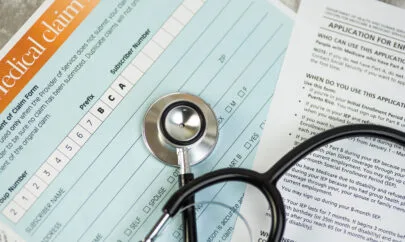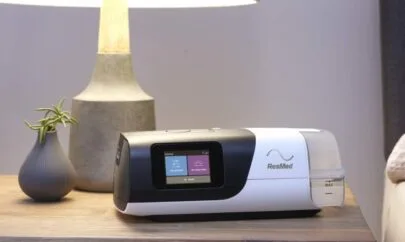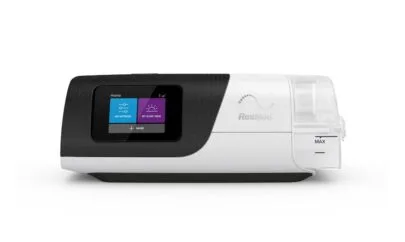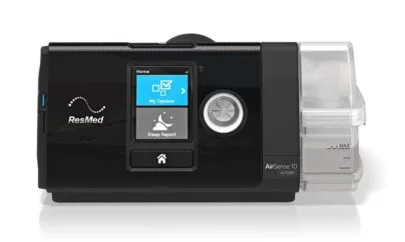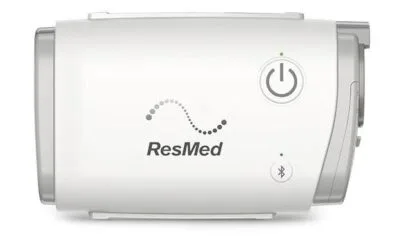
What Is Ramp Time on a CPAP Machine? A Guide for Beginners
Continuous Positive Airway Pressure (CPAP) machines are used to manage and treat sleep apnea. They work by providing a constant stream of pressurised air through a mask during sleep to allow the patient to breathe properly throughout the night. CPAP machines have different features designed to improve the overall experience.
Ramp time on a CPAP machine refers to the period during which the air pressure increases from a low, comfortable level to the prescribed therapeutic level. Understanding this feature, for instance, in devices like the ResMed AirSense 11, is vital for ensuring a comfortable and effective therapy experience.
Ramp time is designed to help you fall asleep more easily by avoiding the immediate discomfort of high-pressure air. The gradual increase in air pressure is especially helpful for new users, allowing them to acclimate to the sensation of pressurized air and making it easier to drift off to sleep.
Whether you’re using a ResMed AirSense 11 or another model CPAP machine, ramp time helps promote comfort and therapy compliance. In this article, we will explore its benefits, customization options, and solutions to common challenges, including how to change ramp time on ResMed 11 if needed.
What is Ramp Time?
The ramp time feature on a CPAP machine allows the gradual increase of air pressure from a lower, more comfortable level to the prescribed therapeutic level. This gradual increase helps users adapt to the feeling of pressurized air, making it easier to fall asleep. This is particularly helpful for new users unfamiliar with the feeling of air gushing into their mouth or nose, allowing them to gradually get used to the sensation.
The ramp function typically starts with a low starting pressure, often set at the lowest possible level (usually around 4 cmH2O), and then incrementally increases the pressure over a set period until it reaches the target pressure prescribed by your doctor.
Standard Settings and Adjustments
The standard settings for ramp time can vary, but most CPAP machines default to a ramp time of about 45 minutes. However, this duration is highly adjustable to suit individual needs. Users can typically adjust the ramp timer in 5-minute increments, with some machines allowing ramp times as long as 60 minutes.
For example, the ResMed AirSense 10 and AirSense 11 feature an automatic ramp timer that keeps the pressure low until it detects that you have fallen asleep and gradually raises it to your prescribed level.
Most machines allow you to increase or decrease the ramp duration based on how long it takes you to fall asleep. If the default 45-minute setting is not sufficient, you can extend it to 60 minutes or adjust it in smaller increments. Additionally, some machines offer the option to control the air pressure increase at specific intervals, such as every 5 minutes within a 45-minute slot. This flexibility ensures that you can customize the ramp time to your preferences.
Enhancing Comfort
Customizing the ramp time on your CPAP machine can significantly enhance your overall comfort with the therapy. By adjusting the ramp time, you can alleviate the discomfort often associated with the initial high air pressure. This is particularly beneficial for new users or those who are sensitive to air pressure changes.
A well-set ramp time allows the air pressure to increase gradually, making it more tolerable to fall asleep. This will increase the likelihood that you will consistently use the CPAP machine.
This can also reduce the anxiety or stress that some people experience when starting CPAP therapy. By beginning with a lower starting pressure and gradually increasing it, you can become accustomed to the feeling of pressurized air without the immediate discomfort, so you are more likely to stick with the treatment plan.
Impact on Sleep Onset
The ramp time setting will directly impact the time it takes you to fall asleep. If the pressure is high to begin with, then it can be difficult to fall asleep. If the pressure is gentle and increases gradually, then the patient is likely to fall asleep more easily.
If you take longer to fall asleep, a longer ramp time can benefit you greatly. On the other hand, those who fall asleep quickly may prefer a shorter ramp time. Experimenting with different ramp time settings can help you find the optimal duration that matches your sleep onset latency. This helps ensure that you are comfortable and that the therapy is effective, leading to better sleep quality and overall health outcomes.
Difficulty Falling Asleep During Ramp Time
Many patients find that high-pressure settings of CPAP make it difficult to fall asleep. If this is the case, you need to have an increased ramp time so that the pressure builds up gradually, allowing you to fall asleep. For instance, if you find that 45 minutes is not sufficient, you can extend the ramp time to 60 minutes or adjust it in smaller increments to find the optimal duration that allows you to fall asleep comfortably.
The automatic ramp feature available on certain CPAP machines, like the ResMed AirSense 10 and AirSense 11, is excellent. These machines use sleep onset detection to maintain a low pressure until they detect that you have fallen asleep, then gradually increase the pressure to your prescribed level.
Adjusting to the Prescribed Pressure
If there is a significant difference between the starting pressure and the prescribed pressure then this can cause certain issues. Patients may wake up during the ramp time due to discomfort or the sound of air rushing into the mask.
Experimenting with different ramp times and starting pressures can help. For example, if the prescribed pressure feels too intense, your healthcare provider might recommend starting with a lower pressure and gradually increasing it over a more extended period. This gradual adjustment allows your body to become accustomed to the higher pressure, reducing discomfort and improving compliance with the therapy.
Features such as expiratory pressure relief (EPR) can also be beneficial. EPR lowers the pressure during exhalation, making it easier to breathe out against the air pressure. This can be particularly helpful for individuals who find high-pressure settings uncomfortable.
Take Time to Learn About Ramp Time
CPAP machines have different features that promote comfort and adherence. Ramp time allows you to increase air pressure from a comfortably low level to the therapeutic level at your preferred pace making it easier to fall asleep and remain comfortable throughout the night. You can adjust the ramp time to your preference until you find the optimum setting for your needs.
Ramp time is particularly beneficial for new users or those sensitive to air pressure changes. Adjusting the ramp time to suit your needs can improve sleep onset latency and overall sleep quality.
Controlling your CPAP therapy can significantly enhance your treatment experience and overall health outcomes, so experiment with your CPAP machine alongside your doctor or healthcare provider for maximum results.






